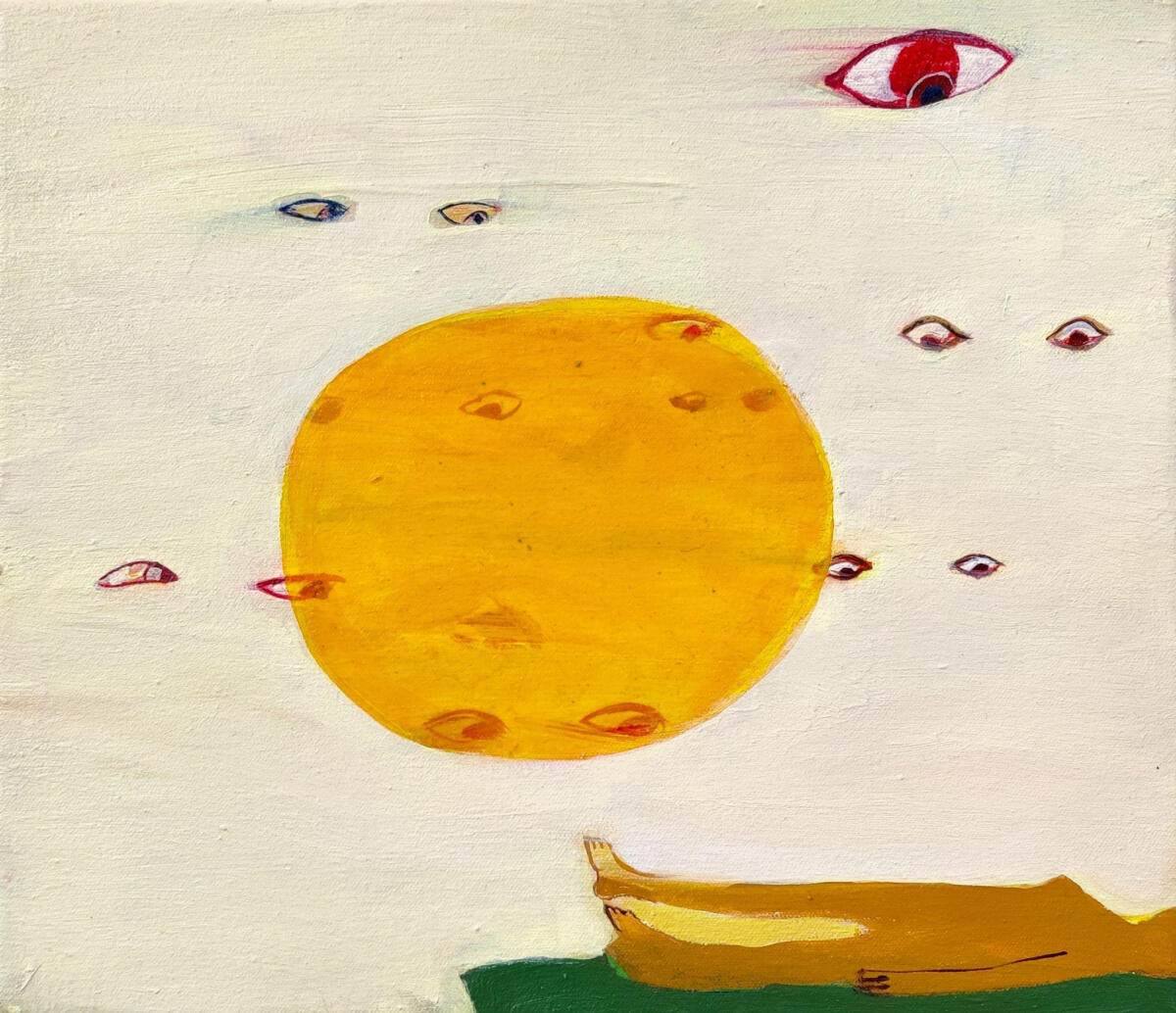To (dis)mantle thoughts on painting
What is the environment, the context, of painting? What is the framework of the medium of painting, from which interpretative lines can be drawn, guiding a path within a defined area? How does painting exist, or rather: How might it exist—How does it happen to exist?

The exhibition Habitats by the Painting Department of the University of the Arts Helsinki’s Academy of Fine Arts gathers works by 30 students, each engaging with the medium of painting in relation to itself. The exhibition concretely and straightforwardly explores how painting and our understanding of it consist of a range of divergent gestures, rather than representing a formal or procedural approach. In the context of Habitats, the focus is on whether painting is tied to recognizability, and if so, in what ways.
Painting as a medium has been historically, artistically, and theoretically tested in particular ways. Within the structures of art history—which sometimes rely on (and are shaped by) violent categorizations—painting has been interpreted and continues to be seen as, for example, a vehicle for virtuosity, an expression of emotion, and a means of conveying knowledge.
It can generally be stated that the (linguistic) definition of all art—its interpretation—is always an incomplete endeavor, as a concept never fully encapsulates a work of art. However, in painting, this issue is compounded by a unique historical weight, encompassing structural and infrastructural dimensions such as visuality, cultural-historical frameworks, and the institutional practices of art academies. There is also an understanding of the inherent incompleteness of interpretation, particularly when the “death” of painting has been proclaimed repeatedly, to the point where its death is seen both as a defining and a requisite characteristic of the medium.[1]
The connection between painting and philosophical discourse has been significant, and the convergence of theoretical and practical domains of art has diversified the field of painting. In contemporary art, works classified as paintings are no longer necessarily recognizable as such by sight alone. As critic and writer Louis Doulas has observed, painting can encompass almost anything—if it doesn’t already include everything.
Attempts have been made to conceptualize painting through the medium itself, yet the conceptual nature of painting can never be fully achieved. One must reach out and examine the nature of this reaching, its characteristics. In this way, the idea of argumentation within painting is reshaped: How can one present a categorized claim about an artwork when the subject of the argument cannot be fully defined within its framework?
When discussing an exhibition by a particular department of a specific art academy, the significance of context becomes apparent. As critic and philosopher Daniel Birnbaum, who has written about art education, has noted, art academies are markedly local actors among art institutions, deeply embedded in their local contexts.[2] Art academies help define their local art scenes—in this case, Helsinki’s exhibition calendar—and, over time, influence the type of art that is presented, studied, collected, and, ultimately, created in Finland. Through the new Mylly building of the Academy of Fine Arts, where Habitats is on display, this definition also unfolds locally, as the university and the art it produces are not physically separated from each other.
However, locality does not automatically equate to active participation; participation in the surrounding society must be consciously built. Following Birnbaum’s reasoning, one might argue that an art academy can easily become its own closed microcosm. While the exhibition forms a momentary community, students of fine arts also engage with other communities. Drawing lines between these is unnecessary, but differing modes of making art can be sought and discovered within the works and the artists behind them. Painting always carries traces of its creator, its author.
The works in Habitats are thus paintings in a specific place and moment but also reflect particular artistic identities. Many pieces convey the artists’ relationships with painting, subjective and imagined private histories, and explorations of agency between the artist and their work. These approaches to how painting as a medium operates in its context traverse parallel paths, forming multi-voiced, polyphonic narratives. The exhibition also highlights how corporeality and movement within space are integral to the experiential dimensions of a painting exhibition. Visitors can engage with the painting process by, for example, allowing their movement to be guided or reflecting on their relationship with sitting. At the same time, the practices of viewing and experiencing art—of engaging with art—are critically examined.
Beyond the exhibition and the academy, painting itself provides a third essential context. Painting is a multifaceted medium, but it would be reductive to claim it resides in a clearly defined and—following a popular definition in Finland—expanded field, as the expanded boundaries of the field cannot be precisely drawn. It becomes crucial to revisit who defines the meaning of an artwork and what role the artist has in the process of defining it. The act of drawing interpretative lines always depends on the drafter and the surface on which they draw.
Habitats does not aim to categorize painting within specific classes, although connecting and recognizable features can, depending on one’s starting point, be identified. The exhibition can be seen as a symbolic space where the paintings on display simultaneously dismantle and construct our understanding—the concept—of painting. This is not about clothing the medium but rather about the garments it wears: the form in which thought and associated actions are expressed and embodied. Thus, both the whole and the individual works exist simultaneously (even bewilderingly) as autonomous entities, with their only unifying factor being the structural and thematic framework provided by the painting department.
– Eero Karjalainen, Critic, Programme in contemporary art history and theory
[1] Haapala, Leevi (2021) Painting is Dead – Long Live Painting. Finnish Painters articles. https://finnishpainters.fi/haapala-painting/
[2] Birnbaum, Daniel (2007). A Proposal from Frankfurt: Teaching Art. Walther König.
Puheenvuoroja taiteesta ja yhteiskunnasta
Tässä blogissa yhteisömme jäsenet nostavat esiin ajankohtaisia aiheita taidekentältä ja yhteiskunnasta.
Uusimmat julkaisut
Seuraa blogia